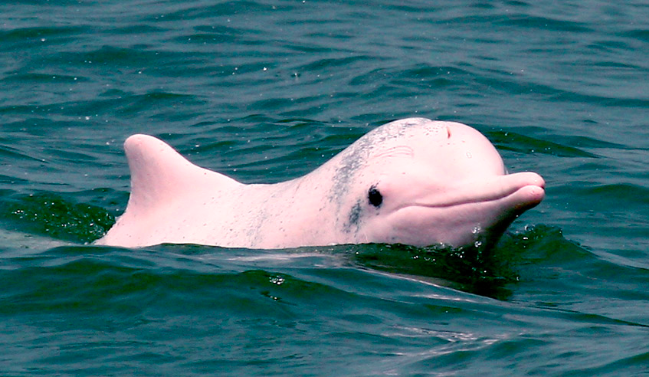Macau (MNA) – Chinese white dolphin population numbers have been greatly impacted by the construction of the Hong Kong-Zhuhai-Macau Bridge, filmmaker and activist, Daphne Wong told MNA.
The Hong Kong filmmaker was responsible for ‘Breathing Room’, a 30-minute documentary detailing how several large scale projects have and will continue to impact the habitat of the animal used as the official Hong Kong mascot for the 1997 handover to Chinese administration.
Involving several interviews with researchers, conservation groups, fishermen and others, the film screening and discussion was held on Saturday at the University of Macau, with the presence of the director and marine life researcher and conservationists, Viena Mak and Roni Wong.
“I thought to showcase Hong Kong’s wildlife. The Chinese White Dolphin is very symbolic for Hong Kong […] and I decided to do it after hearing many news about their numbers dropping and of the many problems related to developments and habitat loss,” she told MNA.
Known officially as the Indo-Pacific Humpback Dolphin, the Chinese White Dolphin or Pink Dolphin is a first-class protected species in China and its global conservation status is currently listed as ‘vulnerable’ on the International Union for Conservation of Nature (IUCN) Red List of Threatened Species.
The species inhabits mainly in the Pearl River Delta, with its habitat in Hong Kong comprising mainly of the southwest areas of the New Territories and Lantau Island.
These areas have been the location of several large scale projects, such as the HZMB, which was constructed between 2009 and 2018, with current projects such as the Hong Kong International Airport third runway and the recently announced reclamation projects Lantau Tomorrow Vision threatening to adding more noise and pollution pressure to dolphin population.

According to official data cited by conservationist groups the number of recorded dolphins in Hong Kong waters has gone from 188 in 2004 to 47 in 2017.
Meanwhile official sightings of dolphins in the whole Pearl River Delta area has gone from 1,167 in 2005 to 945 in 2018.
The intense ferry and boat traffic between Macau and Hong Kong was also said to greatly impact dolphin populations, with works connected to the HZMB said to have driven the dolphins out of they’re natural living spaces in northwest Lantau to southwest of the island, near Tai O or the Soko Islands, where marine traffic channels pose other dangers to the animals.
“The HZMB also caused great habitat reduction and now we have the third runway on-going project. The dolphins are facing a lot of problems including water and noise pollution, and marine traffic. I wanted to give them a voice,” Wong told MNA.
High speed ferries noise pollution was said to disrupt dolphin’s feeding habits and communication, with ships also regularly injuring the animals.
“Basically every 15 minutes there will be four high speed ferries passing through their waters, which produce a lot of noise pollution,” she added.

Some of the conservationist groups requests to Hong Kong authortiies to improve the dolphins life conditions include to move ferry routes to an area south of the Soko Islands, and the increase of areas considered as protected living grounds to encompass the whole west side of Lantau.
“This way the dolphins will have at least some space to live and a last haven not impacted by coastal developments,” the filmmaker and wildlife photographer told MNA.
A petition set by the Hong Kong Dolphin Conservation Society to request these changes was said to have gathered a considerable number of signatures but with the young filmmaker stating response by authorities has been mute. Efforts have also been made to discuss the issue with ferry operators.
Wong’s end of the year project after her Marine & Natural History Photography course at Falmouth University, the documentary earned a nomination for “Best Young Talent” at the Innsbruck Nature Film Festival.
Some rare sightings of Pink Dolphins have been recorded in Macau, with the city’s territorial waters not being considered one of their registered living areas.





















